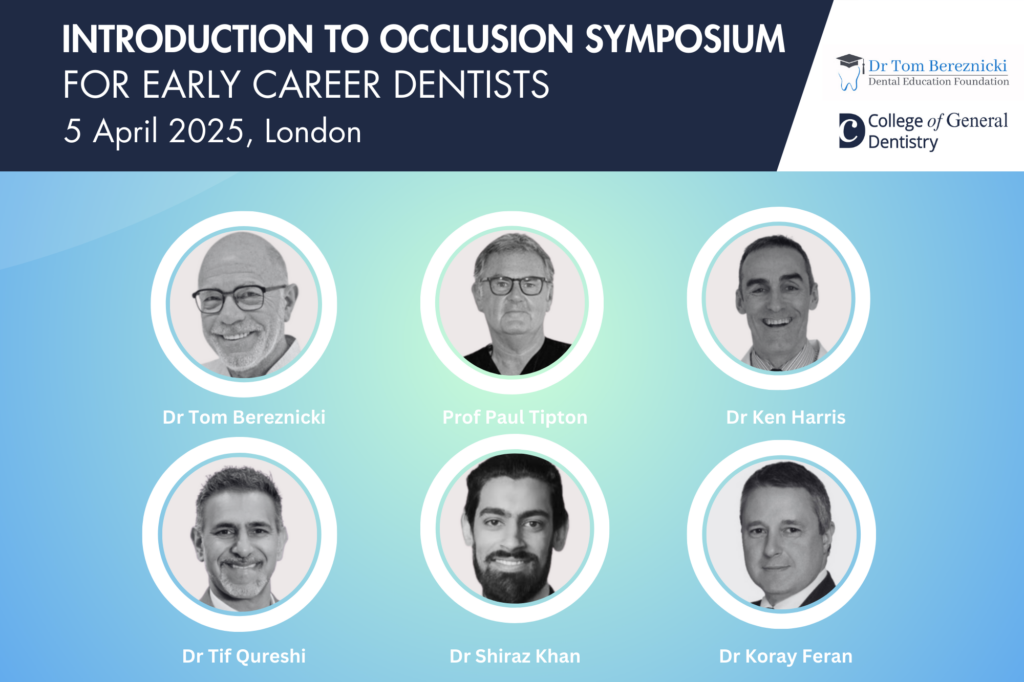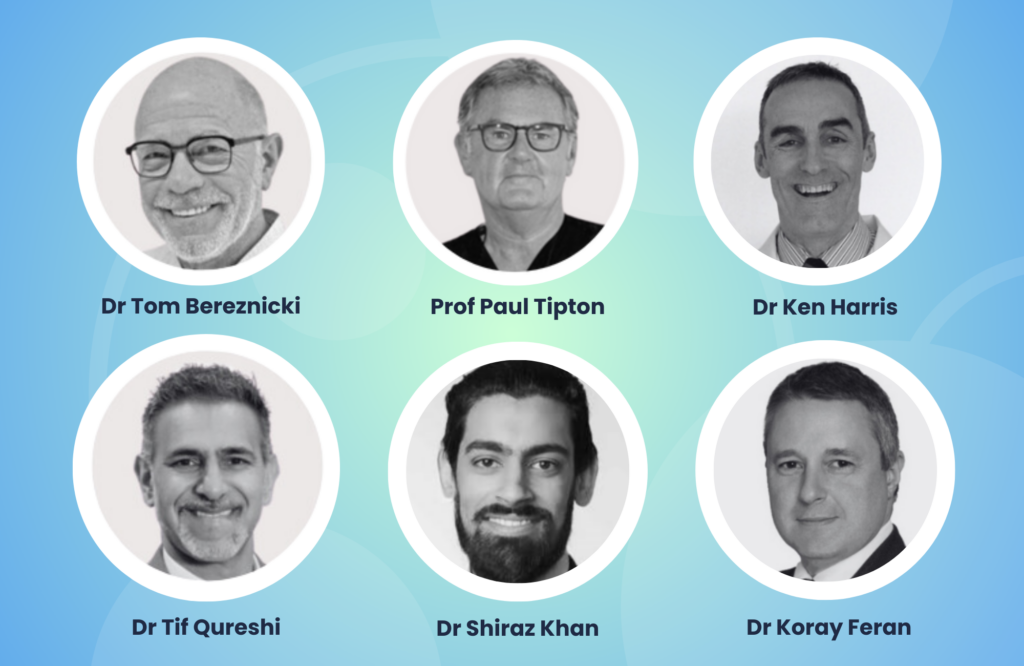
Saturday 5 April 2025, 9am-5pm
£75 per delegate
This button links to dentistry.co.uk where you can register for the symposium.
The secrets of successful, long-term restorations
A solid understanding of the principles of occlusion is crucial for the provision of successful, long-term restorative treatments for tooth wear and other conditions. This one-day symposium for early career dentists on the fundamentals of occlusion, aims to enhance your knowledge in this field. You will leave the day with a deeper knowledge of the basic principles of occlusion and an introduction to a range of postgraduate courses you may wish to consider undertaking in order to extend your knowledge further.
Who is eligible to attend?
The Symposium is aimed at early career dentists. It is open to dentists who qualified in the UK or overseas between 2019 to 2023 and have been practising in the UK for at least the past two years.
If you qualified in 2024 or before 2019, you may register on our reserve list and we will contact you if a place becomes available. The reserve list is available at bit.ly/occlusion-symposium
Expert speakers
Our line-up of renowned speakers are all experts in the field and are committed to delivering high-quality education.
Symposium fee: £75
To ensure the Symposium is accessible to all early career dentists, we have kept the fee at an affordable rate. The reduced cost has largely been made possible by the generosity of the speakers, who have kindly provided their time and expertise free of charge.
If you need to cancel your booking, we will provide a full refund up to 14 days before the event.
Verifiable CPD: 7 hours
Programme
A packed programme of lectures will provide you with a comprehensive introduction to the principles of occlusion. Click on the speakers’ names to view their session details.
08:15-08:50 – Registration – Tea/coffee provided
09:00-09:30 – Dr Tom Bereznicki >
- Welcome and introduction
- Why does occlusion matter?
- Introduction – The Five Basic Principles of Occlusion:
- Stable contacts on all teeth of equal intensity in centric relation – posterior stability
- Anterior guidance in harmony with the envelope of function
- All posterior teeth disclude during mandibular protrusive movements – mutually protected occlusion
- All posterior teeth disclude on the working side during mandibular lateral excursions
- All posterior teeth disclude on the non-working side during mandibular lateral excursions
09:30-11:00 – Professor Paul Tipton >
- Signs/Symptoms of Occlusal Disease
- Causes of wear
- Terminology
- Stable contacts on all teeth of equal intensity in centric relation – posterior stability
- Where should the condyles be and the advantages of Retruded Axis
- Position (RAP) v Intercuspal position (ICP)
- Retruded Contact Posit on (RCP) = (ICP) v (RAP)
- Conformative v reorganised occlusion – with reference to wear cases
- Large vertical, small horizontal and large vertical slides
- Large horizontal, small horizontal and horizontal slides
REFRESHMENT BREAK
11:00-11:30 – Refreshment break – Tea/coffee provided
11:30-13:00 – Dr Ken Harris >
- Centric relation
- Deprogramming and why
- How – deprogrammers eg Nti, Kois, B splint, Michigan and how they work
- Is one any better than the other?
- Facebows and occlusal registration
LUNCH BREAK & PG EDUCATION STANDS
14:00-15:15 – Dr Tif Qureshi & Dr Shiraz Khan>
- What is anterior guidance and why is it important?
- What is the envelope of function and why is it important in the provision of anterior restorations and in particular wear cases?
- Causes of restricted envelope of function and treatment
- Tectonic plates
- Does it matter if the patient has no anterior guidance?
REFRESHMENT BREAK
15:15-15:45 – Refreshment break – Tea/coffee provided
15:45-16:45 – Dr Koray Feran >
- Introduction to the importance of dynamic occlusion when assessing a patient and explain the terms of working side and non-working side when examining patients and planning occlusal form
- Understand how to observe and record inside-out and outside-in movements and tooth contacts and preventing and diagnosing occlusal disease
- Understand
- Understand what may happen if disclusion in lateral excursions is not achieved and what the alternatives or long term management may be in compromised situations
- Understand what is meant by long centric and its significance in analysing and planning occlusions
16:45-17:00 – Dr Tom Bereznicki >
- Is occlusion just as important or more important when providing implants?
- Closing remarks
About the Symposium
The aim of the Introduction to Occlusion Symposium is to provide you with an understanding of the principles of occlusion and how these principles can support the placement of successful, long-term restorations for patients presenting with tooth wear and other conditions.
If you are interested in developing your knowledge of occlusion further following the Symposium, you are invited to visit our education stands around the venue to find out more about a range of high-quality postgraduate courses on this topic, several of which are delivered by our speakers.
The Symposium has been organised by the Tom Bereznicki Charitable Educational Foundation in conjunction with the College of General Dentistry, and is hosted by the charity’s founder, Dr Tom Bereznicki. The Foundation supports educational opportunities for early career dentists in the UK.
You will gain 7 hours verifiable CPD, GDC Development Outcome C.
Lunch and refreshments
Lunch is not provided in the venue. You are welcome to bring your own lunch or visit the restaurants, cafes and shops on the doorstep.
Tea, coffee and biscuits are provided throughout the event.
Getting there
The venue address is: Kensington Conference and Events Centre, Kensington Town Hall, Thornton Street, London, W8
Kensington Conference and Events Centre is easy to access on public transport and a car park is also available onsite.
London Underground – the nearest London Underground station is High Street Kensington on the Circle or District Line.
Bus – busses 9, 10, 27, 28, 49, 52, 70, 328, C1 stop near the venue. Exit the bus at the Kensington High Street/Wrights Lane junction. Alternatively, busses 52 or 70 stop at nearby Kensington Church Street.
Car Parking – there is a public car park below the Kensington Conference and Events Centre. To access it, enter Campden Hill Road from Kensington High Street, turn first right into Phillimore Walk and turn immediately left down the entrance ramp to the car park.
Kensington Conference and Events Centre is fully accessible for anyone with mobility issues.
We look forward to seeing you there!
This button links to dentistry.co.uk where you can register for the symposium.
Cancellation and refund policy
A full refund will be provided up to 14 days before the date of the symposium. No refund will be issued within 14 days of the event. If you would like to cancel your place and request a refund, please email us at contact@cgdent.uk
No refund will be made for non-attendance.
Places are non-transferable to other events.
Follow us on social media:
